The highest tsunami wave in history
When I read about the height of the wave caused by the tsunami in 1958, I couldn't believe my eyes. I checked it once, twice. It was the same everywhere. No, maybe they made a mistake with the comma, and everyone is copying from each other. Or maybe in units of measurement?
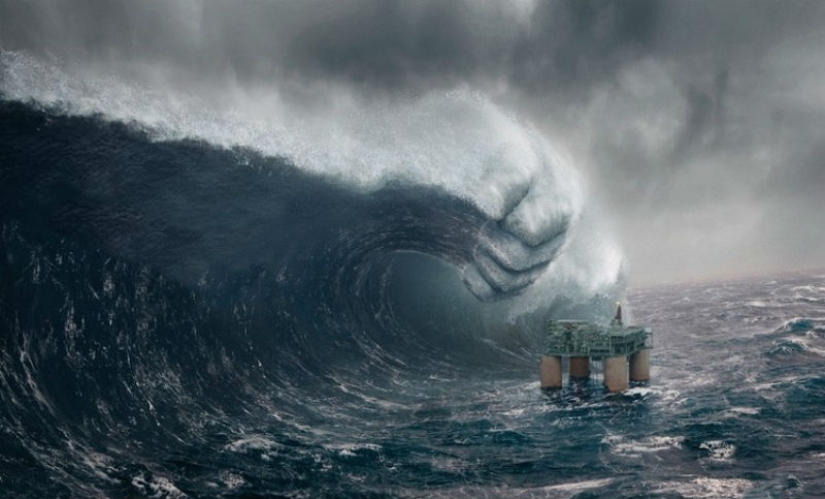
Well, how else, do you think there could be a tsunami wave 524 meters high? HALF A KILOMETER!
Now we will find out what really happened there."
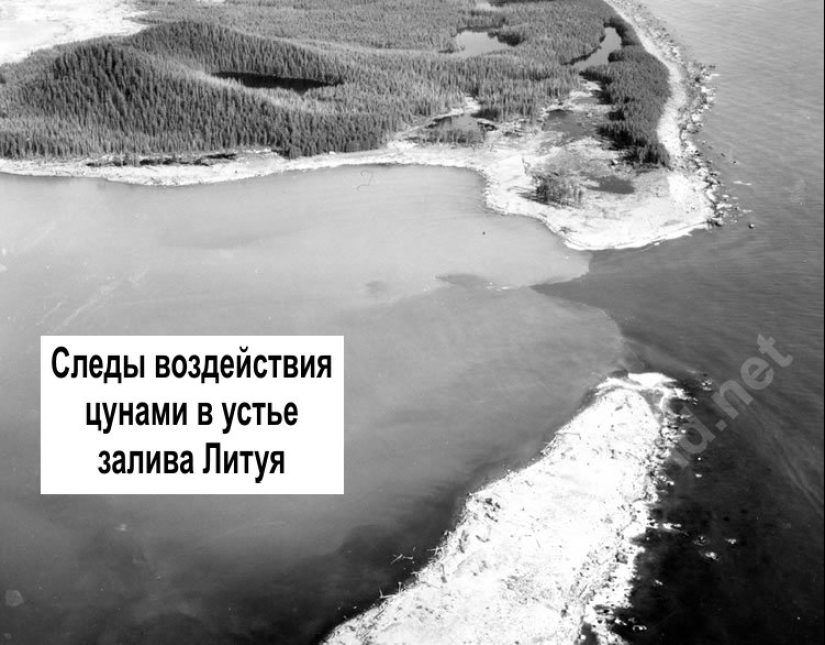
This is what an eyewitness writes:
“After the first shock I fell out of bed and looked toward the head of the bay where the noise was coming from. The mountains were shaking terribly, rocks and avalanches were rushing down. And what was especially striking was the glacier to the north, they call it the Lituya Glacier. It’s not usually visible from where I was anchored. People shake their heads when I tell them I saw it that night. I can’t help it if they don’t believe me. I know it’s not visible from where I was anchored in Anchorage Bay, but I also know that I saw it that night. It rose into the air and moved forward until it was visible.
"It must have gone up several hundred feet. I don't mean it was just hanging in the air. But it was shaking and jumping like crazy. Big chunks of ice were falling off the surface into the water. The glacier was six miles away, and I could see big chunks of ice falling off it like a big dump truck. This went on for a while - it's hard to say how long - and then suddenly the glacier disappeared from view and a big wall of water came up over the place. The wave came our way, and then I was too busy to say what else was going on."
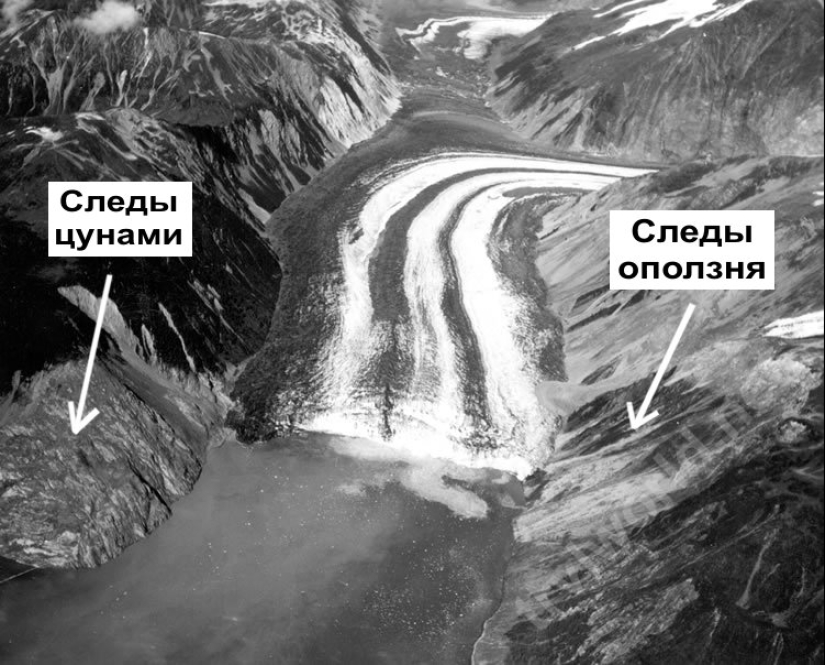
On July 9, 1958, an unusually strong catastrophe occurred in Lituya Bay in southeastern Alaska. In this bay, which juts out into the land for more than 11 km, geologist D. Miller discovered a difference in the age of trees on the slopes of the hills surrounding the bay. Based on the annual rings of the trees, he calculated that over the past 100 years, waves with a maximum height of several hundred meters had occurred in the bay at least four times. Miller's conclusions were treated with great distrust. And then on July 9, 1958, a strong earthquake occurred to the north of the bay on the Fairweather fault, causing the destruction of buildings, the collapse of the coast, and the formation of numerous cracks. And a huge landslide on the slope of the mountain above the bay caused a wave of a record height (524 m), which rolled along a narrow, fjord-like bay at a speed of 160 km / h.
The 1958 earthquake caused a subaerial rockfall at the mouth of the Gilbert Glacier in Lituya Bay. The landslide sent more than 30 million cubic meters of rock into the bay, creating a megatsunami. Five people died in the disaster: three on Hantaak Island and two more washed away in the bay. In Yakutat, the only permanent settlement near the epicenter, infrastructure such as bridges, docks, and oil pipelines were damaged.
After the earthquake, a study was conducted of the subglacial lake located northwest of the bend of the Lituya Glacier at the very beginning of the bay. It turned out that the lake had dropped by 30 meters. This fact served as the basis for another hypothesis about the formation of a giant wave more than 500 meters high. Probably, during the glacier's descent, a large volume of water entered the bay through an ice tunnel under the glacier. However, the water runoff from the lake could not have been the main cause of the megatsunami.
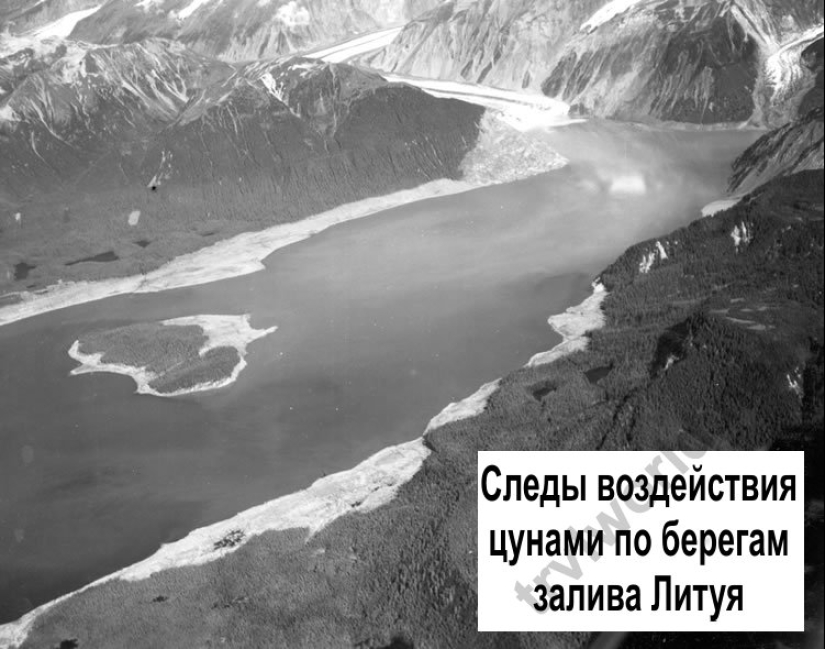
A huge mass of ice, rocks and earth (with a volume of about 300 million cubic meters) rushed down from the glacier, exposing the mountain slopes. The earthquake destroyed numerous buildings, cracks appeared in the ground, the coast slid down. The moving mass fell on the northern part of the bay, covered it, and then crawled up the opposite slope of the mountain, tearing off the forest cover to a height of more than three hundred meters. The landslide generated a giant wave, which literally carried Lituya Bay towards the ocean. The wave was so large that it completely washed over the sandbank at the mouth of the bay.
The catastrophe was witnessed by people on board ships that had dropped anchor in the bay. The terrible shock threw them all out of their bunks. Jumping to their feet, they could not believe their eyes: the sea had risen. "Giant landslides, raising clouds of dust and snow in their path, began to run along the mountain slopes. Soon their attention was drawn to a completely fantastic sight: the mass of ice of the Lituya Glacier, located far to the north and usually hidden from view by the peak that rises at the entrance to the bay, seemed to rise higher than the mountains and then majestically collapsed into the waters of the inner bay.
It all seemed like a nightmare. Before the eyes of the shocked people, a huge wave rose up and swallowed the foot of the northern mountain. After that, it rolled across the bay, tearing trees from the mountain slopes; crashing down on the island of Cenotaphia as a mountain of water… rolled over the highest point of the island, rising 50 m above sea level. All this mass suddenly fell into the waters of the narrow bay, causing a huge wave, the height of which, apparently, reached 17-35 m. Its energy was so great that the wave furiously rushed across the bay, lapping the slopes of the mountains. In the inner basin, the impact of the wave on the shore was probably very strong. The slopes of the northern mountains facing the bay were exposed: where there used to be a dense forest, there were now bare rocks; this picture was observed at an altitude of up to 600 meters.
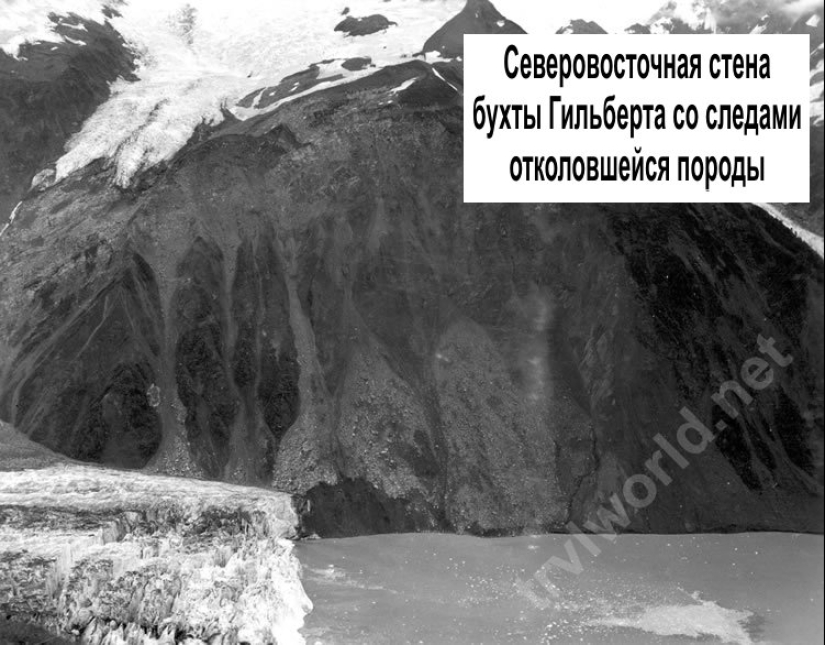
One launch was lifted high, easily carried over the sandbank and dropped into the ocean. At the moment when the launch was carried over the sandbank, the fishermen on it saw standing trees beneath them. The wave literally threw the people across the island into the open sea. During the nightmarish ride on the giant wave, the small vessel pounded against trees and debris. The launch sank, but the fishermen miraculously survived and were rescued two hours later. Of the two other launches, one survived the wave safely, but the other sank, and the people on it were missing.
Miller found that the trees growing at the upper edge of the exposed area, just below 600 m above the bay, were bent and broken, their fallen trunks pointing toward the mountain top, but their roots were not torn out of the soil. Something had pushed these trees upward. The enormous force that had done this could not have been anything other than the top of the gigantic wave that had washed over the mountain that July evening in 1958."
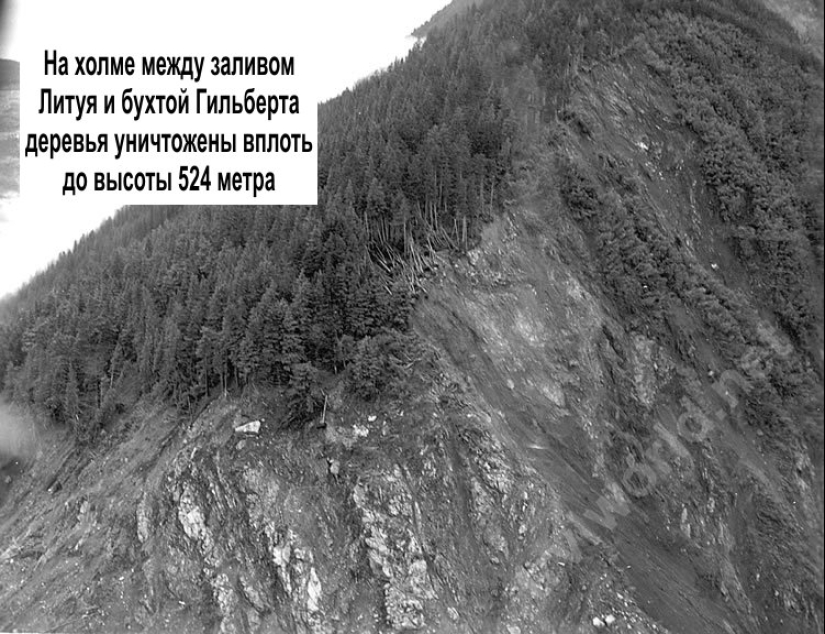
Mr. Howard J. Ulrich, in his yacht, called the Adri, entered Lituya Bay around 8 p.m. and anchored in 30 feet of water in a small cove on the south shore. Howard says the yacht suddenly began to rock violently. He ran out on deck and saw rocks in the northeast corner of the bay being shaken by an earthquake and a huge chunk of rock falling into the water. About two and a half minutes after the earthquake, he heard a deafening sound as the rock broke.
Ulrich said he had seen the entire development of the wave, which had reached their yacht in a very short time – about two and a half to three minutes after it had first been seen. “Because we didn’t want to lose the anchor, we let out the entire anchor chain (about 72 meters) and started the engine. Halfway between the northeastern edge of Lituya Bay and Cenotaph Island, you could see a wall of water about 30 meters high, which stretched from one shore to the other. As the wave approached the northern part of the island, it split into two parts, but after passing the southern part of the island, the wave became one again. It was smooth, only there was a small crest on top. When this mountain of water approached our yacht, its front was quite steep and its height was about 15 to 20 meters.
Before the wave came to the place where our yacht was, we did not feel any lowering of the water or any other changes, except for a slight vibration that was transmitted through the water from the tectonic processes that began to act during the earthquake. As soon as the wave approached us and began to lift our yacht, the anchor chain creaked loudly. The yacht was carried towards the southern shore and then, on the return stroke of the wave, towards the center of the bay. The crest of the wave was not very wide, from 7 to 15 meters, and the back front was less steep than the front.
When the giant wave passed us, the water surface returned to its normal level, but we could see many turbulent eddies around the yacht, as well as random waves of six meters in height, which moved from one side of the bay to the other. These waves did not form any noticeable movement of water from the mouth of the bay to its north-eastern part and back."
After 25-30 minutes, the surface of the bay calmed down. Near the shores, one could see many logs, branches, and uprooted trees. All this trash slowly drifted towards the center of Lituya Bay and its mouth. In fact, during the entire incident, Ulrich did not lose control of the yacht. When the Edri approached the entrance to the bay at 11 p.m., one could observe the normal current, which is usually caused by the daily ebb of ocean water.
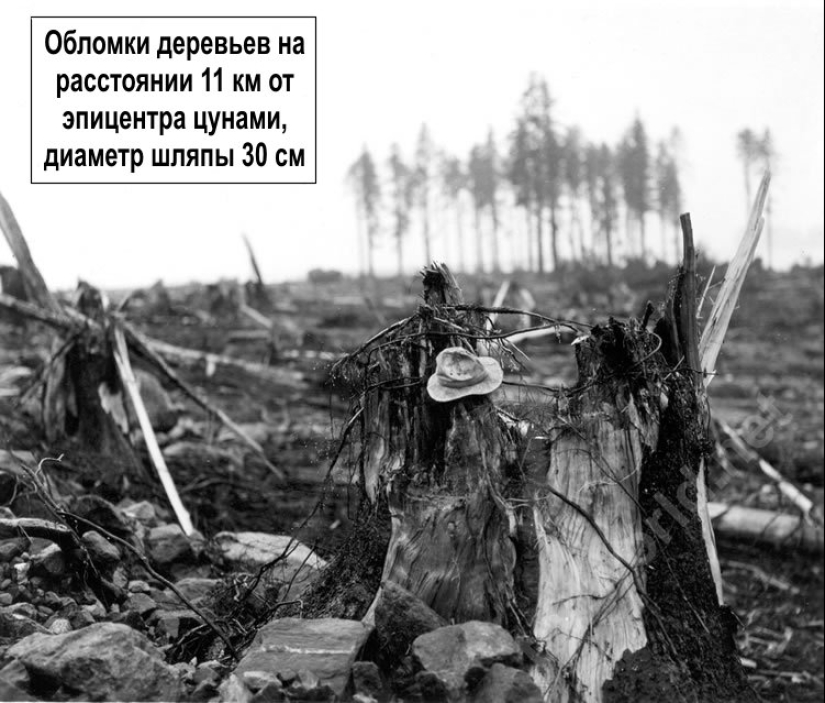
Other eyewitnesses to the disaster, the Swensons on a yacht called the Badger, entered Lituya Bay around 9 p.m. Their vessel first approached Cenotaph Island and then returned to Anchorage Bay on the northern shore of the bay, near its mouth (see map). The Swensons dropped anchor in about twenty-five feet of water and went to sleep. William Swensons' sleep was interrupted by a strong vibration in the yacht's hull. He ran to the control room and began timing what was happening.
A little over a minute after William first felt the vibration, and probably just before the end of the earthquake, he looked toward the northeastern part of the bay, which was visible against the backdrop of Cenotaph Island. The traveler saw what he initially took to be the Lituya Glacier rise into the air and begin to move toward the observer. "It seemed to be a solid mass, but it was jumping and swaying. Large chunks of ice were constantly falling into the water in front of this block." After a short time, "the glacier disappeared from view, and in its place a large wave appeared in that place and went in the direction of La Gaussie Spit, just where our yacht was anchored." In addition, Svenson noted that the wave flooded the shore at a very noticeable height.
When the wave passed Cenotaph Island, it was about 15 meters high in the center of the bay and gradually decreased near the shore. It passed the island approximately two and a half minutes after it was first noticed, and reached the yacht Badger another eleven and a half minutes (approximately). Before the wave arrived, William, as well as Howard Ulrich, did not notice any decrease in the water level or any turbulence.
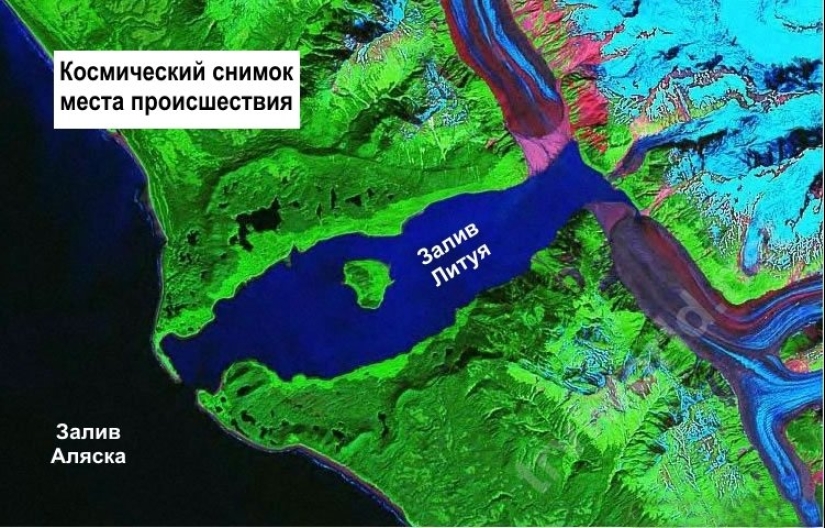
The yacht Badger, which was still anchored, was lifted by a wave and carried towards the La Gaussie Spit. The stern of the yacht was below the crest of the wave, so that the position of the vessel resembled a surfboard. At that moment, Swenson looked at the place where the trees growing on the La Gaussie Spit should have been visible. At that moment, they were hidden by water. William noted that above the treetops there was a layer of water equal to about two lengths of his yacht, about 25 meters.
After passing La Gaussie Spit, the wave began to subside very quickly. In the place where Swenson's yacht was moored, the water level began to drop, and the vessel hit the bottom of the bay, remaining afloat not far from the shore. Three or four minutes after the impact, Swenson saw that the water continued to flow over La Gaussie Spit, carrying logs and other debris from the forest vegetation. He was not sure that this was not a second wave that could carry the yacht over the spit into the Gulf of Alaska. Therefore, the Swensons abandoned their yacht, moving to a small boat, from which they were picked up by a fishing vessel a couple of hours later.
There was a third vessel in Lituya Bay at the time of the incident. It was anchored at the entrance to the bay and was sunk by a huge wave. No one on board survived, but two people are believed to have died.
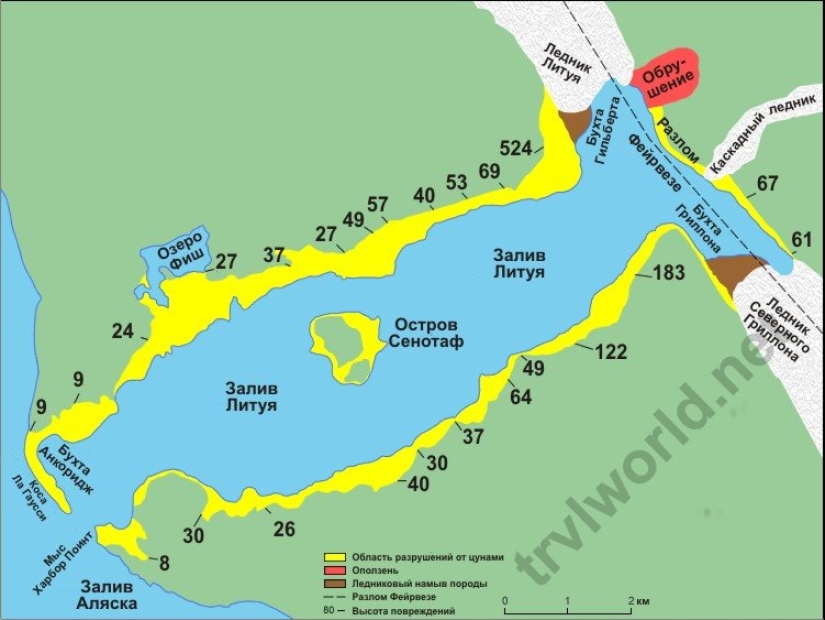
What happened on July 9, 1958? That evening, a huge rock fell into the water from a steep cliff overlooking the northeastern shore of Gilbert Bay. The area of the collapse is marked in red on the map. The impact of an incredible mass of rocks from a very great height caused an unprecedented tsunami that wiped off the face of the earth all living things that were along the entire coast of Lituya Bay all the way to La Gaussie Spit.
After the wave passed, not only was there no vegetation left on both banks of the bay, but there was no soil either; the surface of the shore was bare rock. The area of damage is shown on the map in yellow. The numbers along the shore of the bay indicate the height above sea level of the edge of the damaged land area and roughly correspond to the height of the wave that passed here.
Recent articles

When something spoils, breaks or gets boring, we throw this thing away. In the Middle Ages, when life was treated more simply, ...

There are items, the form of which enters into a stupor. Try to guess what this thing is! Tip: the place — Uzbekistan, ...

Hollywood actors earn a lot of money, sometimes risking their own lives. During the filming, many stars are injured while ...